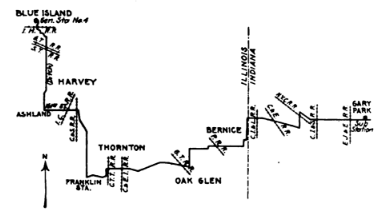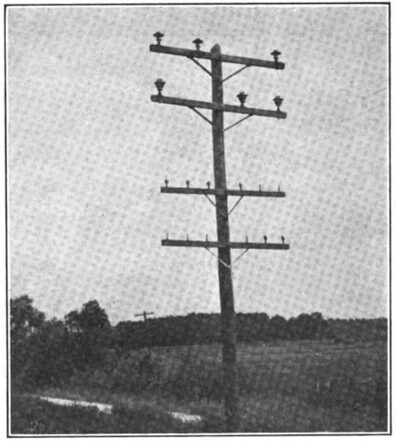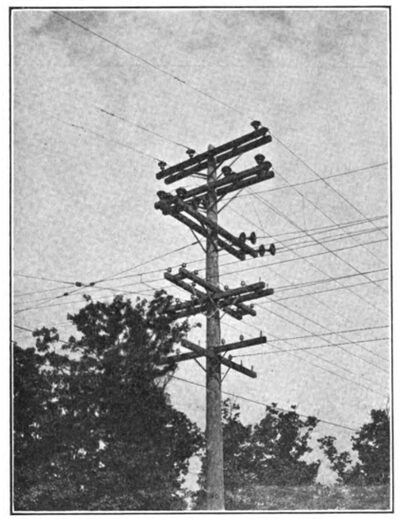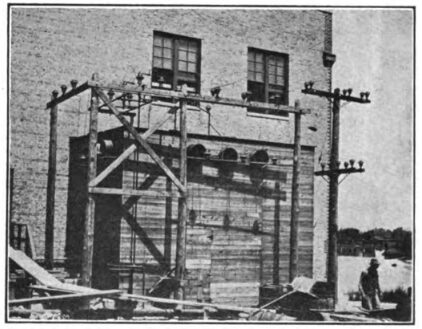[Trade Journal]
Publication: Electrical World
New York, NY, United States
vol. 62, no. 8, p. 387-388, col. 1-2
Field of the Operating Engineer
A Record of Practice, Experience, New Ideas and Interesting
Problems — Notes on Practical Subjects — Questions and Answers
·
·
Quick Change-Over from 12,000 Volts to 33,000 Volts
The Gary & Interurban Railway Company holds trackage rights between Hammond and Laporte, Ind., and at present is operating interurban cars over about 20 miles of track as well as the local cars in Gary. A large portion of the energy used in operating these cars was supplied by the Public Service Company of Northern Illinois over a circuit which tapped the electric service company’s 12,000-volt line running between Blue Island and Chicago Heights, Ill. The transmission line in the State of Illinois is owned by the Public Service Company, and the section in Indiana is owned by the railway company. One substation of the latter at West Gary, containing two 500-kw rotaries, was fed from this line and supplied energy for the operation of the cars over practically the entire road.
Before the railway company’s substation at East Gary was put into operation it was necessary to extend the transmission line and raise the tension to 33,000 volts. The equipment at East Gary consists of two 300-kw rotaries and the accompanying transformers, which are designed to operate on 33,000 volts. As the 1000-kw installation at the 12,000-volt substation in West Gary was carrying a large overload, it was impossible to shift this load over onto a 600-kw station when the change from 12,000 volts to 33,000 volts was made.
 |
| Fig. 1 — Map of Gary & Interurban System |
Electricity supplied by the Public Service Company to the railway is generated at Blue Island, and two 12,000-volt transmission lines are run between the station and Chicago Heights. For this reason it was considered better practice to install the step-up transformers at the generating station rather than at the point where the railway company’s transmission line taps the Public Service Company’s lines. Four 3000-kw, 33,000-12,000-volt oil-filled, water-cooled transformers were purchased by the electric-service company, and two of them were connected open delta and installed in a temporary shed outside of the generating station. These transformers were connected through oil switches to the station busbars and to a 33,000-volt transmission line which was constructed on the same poles with the 12,000-volt line. The 33,000-volt line was supported below the 12,000-volt line, so that the men could work without hazard in the daytime with the upper line energized. The wires on the new line were strung as far as the tie-in point previously mentioned, and the job of dead-ending and connecting to the railway’s line was postponed until the time set for the cut-over.
| |||
| Fig. 2 — Line Construction Between Blue Island Station and Tie-In Point |
A 33,000-volt substation was being built by the railway company at Wilkinson, Ind., in which two 300-kw transformers are to be installed. These transformers were brought to the old substation at West Gary and set up in a temporary structure. Connections were made from them to the substation buses and to the transmission line with the necessary disconnecting switches, and the final connections were left open until the line could be de-energized without interrupting the service.
At midnight, one hour before the railway service ordinarily ceases, the transmission line was de-energized; the old equipment at West Gary was cut out of service and the final connections on temporary transformers were made. At the same time men stationed at the tie-in point on the Public Service Company’s lines dead-ended the 33,000-volt line from Blue Island, erected a buck-arm for a right-angle turn, disconnected the line paralleling the railroad tracks from the 12,000-volt line and connected it to the new 33,000-volt line. While this work was going on tests were made to see that the transformers were installed with proper phase relations and the entire line was tested for stability. Meanwhile the construction men were kept on the grounds so that the connections could be changed back to the 12,000-volt line in case any serious difficulties were encountered. At 4 a.m. the oil switches at Blue Island were closed and the line was energized. No difficulty was experienced in executing the plan, and the line has been working satisfactorily ever since.
| |||
| Fig. 3 — Buck-Arm Construction at Tie-In Point |
The original branch line feeding the railroad having been designed for 12,000 volts, a sufficient factor of safety was not left by using the old insulators. This line, which was about 15 miles long, was re-equipped with insulators suitable for 33,000 volts between the hours of 1.30 a.m. and 4.30 a.m. on the nights preceding the final change. During this time the line was de-energized and the men did not have to work under any hazard. In fact the entire work was carried on with careful guard for the lives of the men.
| |||
| Fig. 4 — Temporary Transformer Installation at Blue Island |
All of the connections and installations which were made during the night on which the line received its first energy at 33,000 volts are not permanent. The line construction is, however. What remains to be done is to rewind the old transformers which were formerly used in the West Gary substation so that they can be used on 33,000 volts. After this is done the transformers which are now being used in the substation will be replaced by those rewound, and the new ones will be installed in the substation at Wilkinson, for which they were originally purchased. An addition is being made on the generating station at Blue Island to receive the 3000-kw transformers when they are permanently installed. As soon as this extension is made two of the four 3000-kw transformers which were purchased by the Public Service Company will be set up and connected in open delta. Between 1130 and 4:30 a. m., when the energy is not needed, the 33,000-volt line will be shifted over to them from the temporary transformers outside of the station. One of the temporary transformers will then be connected in the open delta and the system will be in its final form.
The method adopted by the Public Service Company for installing the transformers and converting the system from a 12,000-volt to a 33,000-volt system without any service interruptions is ingenious and worked out well in practice. Mr. J. C. Gapen, engineer of electrical distribution, had charge of the construction, and Mr. Alfred Herz was testing engineer in charge of the final inspection which determined whether the connections were correct.



